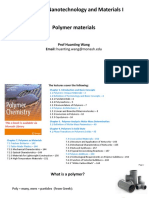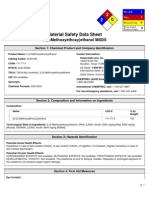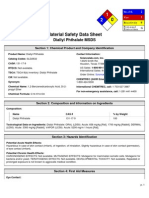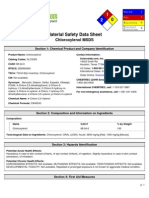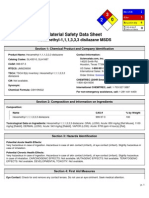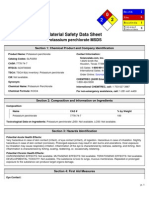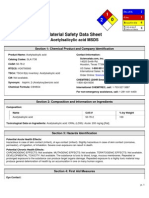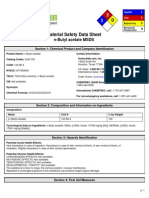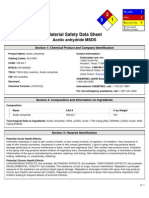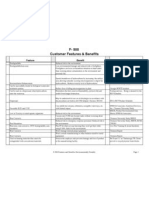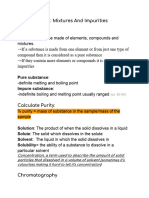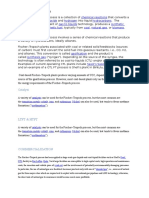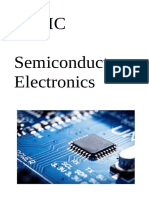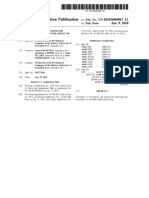Acetophenone PDF
Acetophenone PDF
Uploaded by
Yuliana Ja'farCopyright:
Available Formats
Acetophenone PDF
Acetophenone PDF
Uploaded by
Yuliana Ja'farOriginal Title
Copyright
Available Formats
Share this document
Did you find this document useful?
Is this content inappropriate?
Copyright:
Available Formats
Acetophenone PDF
Acetophenone PDF
Uploaded by
Yuliana Ja'farCopyright:
Available Formats
2 1
Material Safety Data Sheet
Acetophenone MSDS
Section 1: Chemical Product and Company Identification
Product Name: Acetophenone Catalog Codes: SLA2425 CAS#: 98-86-2 RTECS: AM5250000 TSCA: TSCA 8(b) inventory: Acetophenone CI#: Not applicable. Synonym: Ketone methyl phenyl Chemical Name: 1-Phenyl-ethanone Chemical Formula: C6H5COCH4 Contact Information: Sciencelab.com, Inc. 14025 Smith Rd. Houston, Texas 77396 US Sales: 1-800-901-7247 International Sales: 1-281-441-4400 Order Online: ScienceLab.com
He a lt h
1 2 0 J
Fire Re a c t iv it y P e rs o n a l P ro t e c t io n
CHEMTREC (24HR Emergency Telephone), call: 1-800-424-9300 International CHEMTREC, call: 1-703-527-3887 For non-emergency assistance, call: 1-281-441-4400
Section 2: Composition and Information on Ingredients
Composition: Name Acetophenone CAS # 98-86-2 % by Weight 100
Toxicological Data on Ingredients: Acetophenone: ORAL (LD50): Acute: 815 mg/kg [Rat.]. 740 mg/kg [Mouse]. DERMAL (LD50): Acute: 15900 mg/kg [Rabbit].
Section 3: Hazards Identification
Potential Acute Health Effects: Very hazardous in case of eye contact (irritant). Hazardous in case of skin contact (irritant). Slightly hazardous in case of ingestion, of inhalation. Inflammation of the eye is characterized by redness, watering, and itching. Potential Chronic Health Effects: Very hazardous in case of eye contact (irritant). Hazardous in case of skin contact (irritant). Slightly hazardous in case of ingestion, of inhalation. CARCINOGENIC EFFECTS: Not available. MUTAGENIC EFFECTS: Not available. TERATOGENIC EFFECTS: Not available. DEVELOPMENTAL TOXICITY: Not available.
Section 4: First Aid Measures
Eye Contact: p. 1
Check for and remove any contact lenses. Immediately flush eyes with running water for at least 15 minutes, keeping eyelids open. Cold water may be used. Get medical attention immediately. Skin Contact: In case of contact, immediately flush skin with plenty of water. Cover the irritated skin with an emollient. Remove contaminated clothing and shoes. Cold water may be used.Wash clothing before reuse. Thoroughly clean shoes before reuse. Get medical attention. Serious Skin Contact: Wash with a disinfectant soap and cover the contaminated skin with an anti-bacterial cream. Seek immediate medical attention. Inhalation: If inhaled, remove to fresh air. If not breathing, give artificial respiration. If breathing is difficult, give oxygen. Get medical attention. Serious Inhalation: Not available. Ingestion: Do NOT induce vomiting unless directed to do so by medical personnel. Never give anything by mouth to an unconscious person. If large quantities of this material are swallowed, call a physician immediately. Loosen tight clothing such as a collar, tie, belt or waistband. Serious Ingestion: Not available.
Section 5: Fire and Explosion Data
Flammability of the Product: Combustible. Auto-Ignition Temperature: 570C (1058F) Flash Points: CLOSED CUP: 77C (170.6F). OPEN CUP: 82.2C (180F) (Cleveland). Flammable Limits: Not available. Products of Combustion: These products are carbon oxides (CO, CO2). Fire Hazards in Presence of Various Substances: Flammable in presence of open flames and sparks, of heat, of oxidizing materials. Explosion Hazards in Presence of Various Substances: Risks of explosion of the product in presence of mechanical impact: Not available. Risks of explosion of the product in presence of static discharge: Not available. Fire Fighting Media and Instructions: SMALL FIRE: Use DRY chemical powder. LARGE FIRE: Use water spray, fog or foam. Do not use water jet. Special Remarks on Fire Hazards: Store away from direct sunlight. When heated to decomposition it emits acrid smoke and fumes. Special Remarks on Explosion Hazards: Not available.
Section 6: Accidental Release Measures
Small Spill: Dilute with water and mop up, or absorb with an inert dry material and place in an appropriate waste disposal container. Finish cleaning by spreading water on the contaminated surface and dispose of according to local and regional authority requirements. Large Spill: Combustible material. Keep away from heat. Keep away from sources of ignition. Stop leak if without risk. If the product is in its solid form: Use a shovel to put the material into a convenient waste disposal container. If the product is in its liquid form: p. 2
Absorb with an inert material and put the spilled material in an appropriate waste disposal. Finish cleaning by spreading water on the contaminated surface and allow to evacuate through the sanitary system.
Section 7: Handling and Storage
Precautions: Keep away from heat. Keep away from sources of ignition. Ground all equipment containing material. Do not ingest. Do not breathe gas/fumes/ vapor/spray. If ingested, seek medical advice immediately and show the container or the label. Avoid contact with skin and eyes. Keep away from incompatibles such as oxidizing agents, reducing agents, alkalis. Storage: Keep container in a cool, well-ventilated area. Keep container tightly closed and sealed until ready for use. Avoid all possible sources of ignition (spark or flame).
Section 8: Exposure Controls/Personal Protection
Engineering Controls: Provide exhaust ventilation or other engineering controls to keep the airborne concentrations of vapors below their respective threshold limit value. Ensure that eyewash stations and safety showers are proximal to the work-station location. Personal Protection: Splash goggles. Lab coat. Gloves. Personal Protection in Case of a Large Spill: Splash goggles. Full suit. Boots. Gloves. Suggested protective clothing might not be sufficient; consult a specialist BEFORE handling this product. Exposure Limits: Not available.
Section 9: Physical and Chemical Properties
Physical state and appearance: Liquid. (Liquid.) Odor: Not available. Taste: Not available. Molecular Weight: 120.16 g/mole Color: Colorless to light yellow. pH (1% soln/water): 7 [Neutral.] Boiling Point: 201.7C (395.1F) Melting Point: 19.7C (67.5F) Critical Temperature: Not available. Specific Gravity: 1.03 (Water = 1) Vapor Pressure: 0.1 kPa (@ 20C) Vapor Density: 4.1 (Air = 1) Volatility: Not available. Odor Threshold: Not available. Water/Oil Dist. Coeff.: Not available. Ionicity (in Water): Not available. Dispersion Properties: See solubility in water, methanol, diethyl ether. p. 3
Solubility: Soluble in methanol, diethyl ether. Partially soluble in cold water, hot water.
Section 10: Stability and Reactivity Data
Stability: The product is stable. Instability Temperature: Not available. Conditions of Instability: Not available. Incompatibility with various substances: Reactive with oxidizing agents, reducing agents, alkalis. Corrosivity: Non-corrosive in presence of glass. Special Remarks on Reactivity: Not available. Special Remarks on Corrosivity: Not available. Polymerization: Will not occur.
Section 11: Toxicological Information
Routes of Entry: Eye contact. Toxicity to Animals: Acute oral toxicity (LD50): 740 mg/kg [Mouse]. Acute dermal toxicity (LD50): 15900 mg/kg [Rabbit]. Chronic Effects on Humans: Not available. Other Toxic Effects on Humans: Hazardous in case of skin contact (irritant). Slightly hazardous in case of ingestion, of inhalation. Special Remarks on Toxicity to Animals: Not available. Special Remarks on Chronic Effects on Humans: 0900 Detected in maternal milk in human. Special Remarks on other Toxic Effects on Humans: Material is irritating to mucous membranes and upper respiratory tract. Narcotic in high concentrations. Hypnotic.
Section 12: Ecological Information
Ecotoxicity: Not available. BOD5 and COD: Not available. Products of Biodegradation: Possibly hazardous short term degradation products are not likely. However, long term degradation products may arise. Toxicity of the Products of Biodegradation: The products of degradation are more toxic. Special Remarks on the Products of Biodegradation: Not available.
Section 13: Disposal Considerations
Waste Disposal:
Section 14: Transport Information
p. 4
DOT Classification: CLASS 3: Combustible liquid Identification: : FLAMMABLE LIQUIDS, N.O.S. UNNA: UN1993 PG: Not available. Special Provisions for Transport: Not available.
Section 15: Other Regulatory Information
Federal and State Regulations: Pennsylvania RTK: Acetophenone Massachusetts RTK: Acetophenone TSCA 8(b) inventory: Acetophenone SARA 313 toxic chemical notification and release reporting: Acetophenone CERCLA: Hazardous substances.: Acetophenone Other Regulations: OSHA: Hazardous by definition of Hazard Communication Standard (29 CFR 1910.1200). Other Classifications: WHMIS (Canada): CLASS B-3: Combustible liquid with a flash point between 37.8C (100F) and 93.3C (200F). CLASS D-2B: Material causing other toxic effects (TOXIC). DSCL (EEC): R22- Harmful if swallowed. R38- Irritating to skin. R41- Risk of serious damage to eyes. HMIS (U.S.A.): Health Hazard: 1 Fire Hazard: 2 Reactivity: 0 Personal Protection: j National Fire Protection Association (U.S.A.): Health: 1 Flammability: 2 Reactivity: 0 Specific hazard: Protective Equipment: Gloves. Lab coat. Wear appropriate respirator when ventilation is inadequate. Splash goggles.
Section 16: Other Information
References: -Hawley, G.G.. The Condensed Chemical Dictionary, 11e ed., New York N.Y., Van Nostrand Reinold, 1987. -SAX, N.I. Dangerous Properties of Indutrial Materials. Toronto, Van Nostrand Reinold, 6e ed. 1984. -The Sigma-Aldrich Library of Chemical Safety Data, Edition II. Other Special Considerations: Not available. Created: 10/09/2005 03:36 PM Last Updated: 11/01/2010 12:00 PM The information above is believed to be accurate and represents the best information currently available to us. However, we make no warranty of merchantability or any other warranty, express or implied, with respect to such information, and we assume no liability resulting from its use. Users should make their own investigations to determine the suitability of the information for their particular purposes. In no event shall ScienceLab.com be liable for any claims, losses, or damages of any third party or for p. 5
lost profits or any special, indirect, incidental, consequential or exemplary damages, howsoever arising, even if ScienceLab.com has been advised of the possibility of such damages.
p. 6
You might also like
- Formal Report On Partial Molar Volume ExperimentDocument9 pagesFormal Report On Partial Molar Volume ExperimentdatUPstudentdoe100% (5)
- The Health & Safety Guide for Film, TV & Theater, Second EditionFrom EverandThe Health & Safety Guide for Film, TV & Theater, Second EditionRating: 4 out of 5 stars4/5 (1)
- 8-Heat Transfer-2016 - Ans Key-Master FileDocument12 pages8-Heat Transfer-2016 - Ans Key-Master FileLourdes Cagungun100% (2)
- MI SwacoDocument7 pagesMI SwacoRiyadul IslamNo ratings yet
- MS DC 543Document9 pagesMS DC 543Bonifácio Pacheco AmaralNo ratings yet
- CHE3172 Nanotechnology and Materials I: Prof Huanting Wang Email: Huanting - Wang@monash - EduDocument13 pagesCHE3172 Nanotechnology and Materials I: Prof Huanting Wang Email: Huanting - Wang@monash - EduDivya KariaNo ratings yet
- Mineral Spirits - MsdsDocument5 pagesMineral Spirits - MsdsKen StewartNo ratings yet
- Potassium Dichromate MSDS: Section 1: Chemical Product and Company IdentificationDocument6 pagesPotassium Dichromate MSDS: Section 1: Chemical Product and Company IdentificationRicky SetiawanNo ratings yet
- Acetophenon PDFDocument6 pagesAcetophenon PDFYuris Yurdiansah Munandar0% (1)
- EthanolDocument5 pagesEthanolGery Job'sNo ratings yet
- Atropine Ld50Document5 pagesAtropine Ld50valertronNo ratings yet
- Cinna Mal de HideDocument5 pagesCinna Mal de Hiderully1234No ratings yet
- MsdsDocument6 pagesMsdsscribdkthNo ratings yet
- Eugenol MSDS: Section 1: Chemical Product and Company IdentificationDocument5 pagesEugenol MSDS: Section 1: Chemical Product and Company IdentificationLaraz ShawolmvpNo ratings yet
- Material Safety Data Sheet: Tert-Amyl Alcohol MSDSDocument6 pagesMaterial Safety Data Sheet: Tert-Amyl Alcohol MSDSmicaziv4786No ratings yet
- Msds Eugenol PDFDocument5 pagesMsds Eugenol PDFIchlas MuttaqinNo ratings yet
- Diethylene GlycolDocument5 pagesDiethylene Glycolsatnam1979No ratings yet
- Msds DNSADocument5 pagesMsds DNSAfontianikaNo ratings yet
- Pyrolle MsdsDocument5 pagesPyrolle MsdsAmalina HazwaniNo ratings yet
- 2 NaftolDocument5 pages2 Naftolhide999No ratings yet
- Msds Diaseton AlkoholDocument5 pagesMsds Diaseton AlkoholtakenoveraccountNo ratings yet
- Car Boxy Benz Alde HideDocument5 pagesCar Boxy Benz Alde HideReksy WibowoNo ratings yet
- Urea MsdsDocument5 pagesUrea MsdsRea Candra OktaviaraNo ratings yet
- MsdsDocument5 pagesMsdsbindas4uNo ratings yet
- Msds OctaneDocument5 pagesMsds Octanenirmal_subudhiNo ratings yet
- MsdsDocument5 pagesMsdsSe Won KimNo ratings yet
- Msds Acetyl ChlorideDocument6 pagesMsds Acetyl ChlorideghungrudswapnilNo ratings yet
- Isopentane MsdsDocument5 pagesIsopentane Msdslqiroxita100% (1)
- Thiamine HCL MSDS: Section 1: Chemical Product and Company IdentificationDocument5 pagesThiamine HCL MSDS: Section 1: Chemical Product and Company IdentificationAurora Buitrago RuízNo ratings yet
- Chalcone MSDS: Section 1: Chemical Product and Company IdentificationDocument5 pagesChalcone MSDS: Section 1: Chemical Product and Company IdentificationNaveed SajidNo ratings yet
- Terephthalic Acid MSDS: Section 1: Chemical Product and Company IdentificationDocument5 pagesTerephthalic Acid MSDS: Section 1: Chemical Product and Company IdentificationAbhishek KumarNo ratings yet
- Msds TioureaDocument5 pagesMsds TioureaNurul HidayatiNo ratings yet
- Msds BETAINEDocument5 pagesMsds BETAINEamiller1987No ratings yet
- MSDS 1,10 FenantroliinDocument5 pagesMSDS 1,10 FenantroliinmoazrilNo ratings yet
- Msds Butyl AcetateDocument6 pagesMsds Butyl AcetateArsalan Ahmad KhanNo ratings yet
- Naphthol-2 MSDS: Section 1: Chemical Product and Company IdentificationDocument5 pagesNaphthol-2 MSDS: Section 1: Chemical Product and Company IdentificationFebilo RiszkyNo ratings yet
- Potassium Perch Lo Rate MsdsDocument5 pagesPotassium Perch Lo Rate MsdsPavan KumarNo ratings yet
- Msds Isopropil EterDocument5 pagesMsds Isopropil EterLidwina Margaretha LakaNo ratings yet
- Sulindac MSDS: Section 1: Chemical Product and Company IdentificationDocument5 pagesSulindac MSDS: Section 1: Chemical Product and Company IdentificationKumar GalipellyNo ratings yet
- Acetylsalicylic Acid MSDS: Section 1: Chemical Product and Company IdentificationDocument5 pagesAcetylsalicylic Acid MSDS: Section 1: Chemical Product and Company IdentificationAlfrie Carlo ConsebidoNo ratings yet
- Msds ThioacetamideDocument6 pagesMsds ThioacetamideOscar Aviles0% (1)
- ButilacetatDocument6 pagesButilacetatmicaziv4786No ratings yet
- Msds of GlycidolDocument6 pagesMsds of GlycidolDinesh TanwarNo ratings yet
- MSDSDocument6 pagesMSDSAra HilisNo ratings yet
- 22 Amino Benzoic Acid MSDSDocument5 pages22 Amino Benzoic Acid MSDSapple212aNo ratings yet
- 3-Aminobenzonitrile MSDS: Section 1: Chemical Product and Company IdentificationDocument5 pages3-Aminobenzonitrile MSDS: Section 1: Chemical Product and Company IdentificationAdi WibowoNo ratings yet
- Msds Ac2oDocument6 pagesMsds Ac2oArfin FardiansyahNo ratings yet
- Acetic Anhydride MSDS: Section 1: Chemical Product and Company IdentificationDocument6 pagesAcetic Anhydride MSDS: Section 1: Chemical Product and Company IdentificationAdri MuntahaNo ratings yet
- Ferrous Sulfate MSDSDocument5 pagesFerrous Sulfate MSDSJonathan GonzalesNo ratings yet
- MSDS MelaminDocument5 pagesMSDS MelaminFajar Dwi SaputroNo ratings yet
- MsdsDocument6 pagesMsdsWind AzCaNo ratings yet
- 14.kalium DikromatDocument6 pages14.kalium DikromatDarla PowersNo ratings yet
- SfmsdsDocument5 pagesSfmsdsapi-263411629No ratings yet
- Msds C7H5OClDocument6 pagesMsds C7H5OClwindawardhaniNo ratings yet
- Msds Asam TaninDocument6 pagesMsds Asam TaninArfin FardiansyahNo ratings yet
- BoraksDocument5 pagesBoraksyayax_619No ratings yet
- A Consumerýs Dictionary of Household, Yard and Office Chemicals: Complete Information About Harmful and Desirable Chemicals Found in Everyday Home Products, Yard Poisons, and Office PollutersFrom EverandA Consumerýs Dictionary of Household, Yard and Office Chemicals: Complete Information About Harmful and Desirable Chemicals Found in Everyday Home Products, Yard Poisons, and Office PollutersNo ratings yet
- Georgia Pest Management Handbook: 2021 Home and Garden EditionFrom EverandGeorgia Pest Management Handbook: 2021 Home and Garden EditionEmily CabreraNo ratings yet
- Survival Skills: How to Survive Anything and Anywhere in the World (A Comprehensive Guide to Preparing for and Overcoming Challenges of Earthquakes)From EverandSurvival Skills: How to Survive Anything and Anywhere in the World (A Comprehensive Guide to Preparing for and Overcoming Challenges of Earthquakes)No ratings yet
- After a Disaster - Information to Help You and Your Family RecoverFrom EverandAfter a Disaster - Information to Help You and Your Family RecoverNo ratings yet
- Legally Poisoned: How the Law Puts Us at Risk from ToxicantsFrom EverandLegally Poisoned: How the Law Puts Us at Risk from ToxicantsNo ratings yet
- First Aid on the Farm: Natural and Conventional TreatmentsFrom EverandFirst Aid on the Farm: Natural and Conventional TreatmentsNo ratings yet
- Resistivity InterpretationDocument9 pagesResistivity InterpretationhkaqlqNo ratings yet
- 2 Cement HydrationDocument50 pages2 Cement HydrationMelinda GordonNo ratings yet
- Fire Sprinkler Systems ExplainedDocument3 pagesFire Sprinkler Systems ExplainedRomzy KutonNo ratings yet
- Studi Sifat Kimia, Fungsional, Dan Daya Cerna Protein TEPUNG KECAMBAH KACANG TUNGGAK (Vigna Unguiculata (L.) Walp)Document11 pagesStudi Sifat Kimia, Fungsional, Dan Daya Cerna Protein TEPUNG KECAMBAH KACANG TUNGGAK (Vigna Unguiculata (L.) Walp)merfatNo ratings yet
- An Improved Isolation of Trimyristin From Myristica Fragrans As A Renewable Feedstock With The Assistance of Novel Cationic Gemini SurfactantDocument16 pagesAn Improved Isolation of Trimyristin From Myristica Fragrans As A Renewable Feedstock With The Assistance of Novel Cationic Gemini SurfactantNabila PutriNo ratings yet
- P Block ElementsDocument3 pagesP Block ElementsPRADEEP C100% (1)
- A Presentation On: Use of Copper Heat Sink To Improve Quality of Weld in AISI 304LDocument20 pagesA Presentation On: Use of Copper Heat Sink To Improve Quality of Weld in AISI 304Lrakesh ranjanNo ratings yet
- Aquashield: DescriptionDocument3 pagesAquashield: DescriptionRana MahatoNo ratings yet
- BFL f5 Am f-500 Features and BenefitsDocument24 pagesBFL f5 Am f-500 Features and Benefitsapi-109572803No ratings yet
- Povidone Iodine USPDocument2 pagesPovidone Iodine USPJansen B. LaurenNo ratings yet
- Mixtures and ImpuritiesDocument4 pagesMixtures and Impuritieszgvw7kgfy4No ratings yet
- Properties of Metakaolin Based Geopolymer Incorporating Calcium Carbonate (Aboulayt-2017)Document9 pagesProperties of Metakaolin Based Geopolymer Incorporating Calcium Carbonate (Aboulayt-2017)juan diazNo ratings yet
- Reaction Mechanism: Pearl GTL Ras Laffan Qatar Crude Oil Stranded GasDocument2 pagesReaction Mechanism: Pearl GTL Ras Laffan Qatar Crude Oil Stranded Gasranjan1491No ratings yet
- Extraction of Pectin From Mangifera Indica Linn. Indian Mango Fruit PeelDocument3 pagesExtraction of Pectin From Mangifera Indica Linn. Indian Mango Fruit PeelEditor IJTSRDNo ratings yet
- Austenitic Stainless SteelsDocument10 pagesAustenitic Stainless SteelsbramNo ratings yet
- Science Bowl Practice Questions Biology - 1Document111 pagesScience Bowl Practice Questions Biology - 1Kavita KrishnamorthiNo ratings yet
- Heat Transfer Engineering ApplicationsDocument412 pagesHeat Transfer Engineering ApplicationsGanesh Mandpe100% (1)
- Chemistry Worksheet AnswersDocument9 pagesChemistry Worksheet AnswersD AnithaNo ratings yet
- Análise Microestrutural de Concreto Reciclado Usando Microtomografia de Raios X Ingles LEITE E MONTEIRO - ScienceDirectDocument11 pagesAnálise Microestrutural de Concreto Reciclado Usando Microtomografia de Raios X Ingles LEITE E MONTEIRO - ScienceDirectCristine RussellNo ratings yet
- Main Semiconductor Project FileDocument23 pagesMain Semiconductor Project FileAkhilesh DixitNo ratings yet
- 51LB Exp1 W11Document4 pages51LB Exp1 W11KeVin Dean LimNo ratings yet
- Davisson Germer LectureDocument21 pagesDavisson Germer LectureSyed Raheel AdeelNo ratings yet
- Dezincinc of Galvanized Steel PDFDocument278 pagesDezincinc of Galvanized Steel PDFNicat MammadovNo ratings yet
- US20200009067A1Document37 pagesUS20200009067A1M FNo ratings yet
- Antarol FJ 601 - Technical Data SheetDocument1 pageAntarol FJ 601 - Technical Data SheetCARMEN LINARESNo ratings yet





